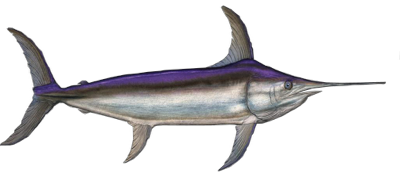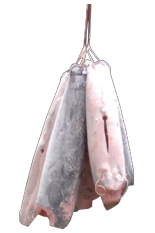BROADBILL SWORDFISH
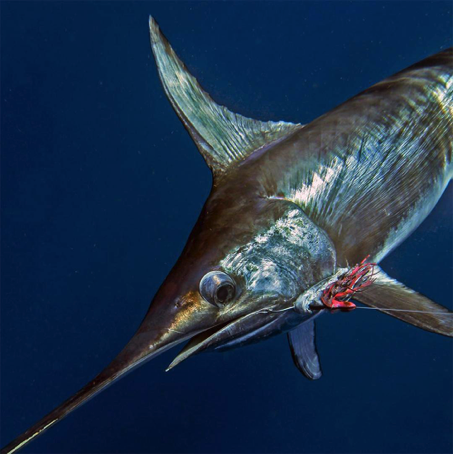
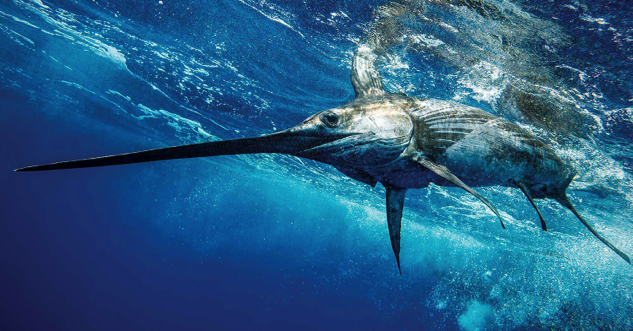
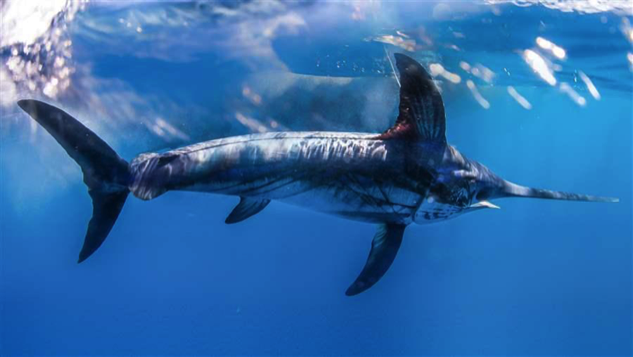
BROADBILL SWORDFISH (Xiphias gladius)
Scientific Name: Xiphias gladius
Market Name: Swordfish
Common Name: Broadbill swordfish, broadbill, espada, emperado
Japanese Name: Mekajiki
Description
The Swordfish, also called the Broadbill Swordfish. As its name implies, this magnificent fish is characterized by an upper jaw that extends to form a flat, sharp-edged "sword" that comprises up to 1/3 of the fishes body length is prized in restaurants and tables around the world. Highly migratory, the sword fish can reach a weight of 1000 pounds, but the average is 200 to 400 pounds and 10 feet long.
This non-schooling fish roams temperate and tropical seas worldwide and is hunted by more than 30 nations. Swordfish grow to over 1,000 pounds but average 50 to 200 pounds. Most are caught by longline; the fishery is conducted at night. The best catches from the longline fleet come on the full moon, when nights are bright and swordfish are feeding heavily. Thus, the best catches occur during the final quarter of the moon. Generally speaking, long-lined fish are considered the best. Frozen-at-sea swordfish, known as “clipper,”
With flesh that varies in colour from white and ivory to pink and orange, it has a firm texture, high oil content and is moist and flavourful if not overcooked.
Physical Characteristics
The swordfish has a stout, fairly rounded body and large eyes. The first dorsal fin (rising from the back of the fish) is tall and crescent-shaped. The second dorsal fin is quite separate from the first and very small. Both are soft-rayed—having thin, bony rods that extend from the base of the fin and support the fin membrane. The anal fins approximate the shape of the dorsal fins, but are noticeably smaller. Ventral fins, found on the underside of fish, are absent. There is a strong, longitudinal keel, or ridge, on either side of the caudal peduncle (the base of the tail where the tail fins project from), which leads to a broad, crescent-shaped tail. Adult swordfish have neither teeth nor scales.
The swordfish snout elongates into a true sword shape. Measuring at least one-third the length of the body, it is long, flat, pointed, and very sharp. The lower jaw is much smaller, though just as pointed, ending in a very wide mouth.
Physical Characteristics cont..
The swordfish is named after its sharp beak resembling a sword, which together with its streamlined physique allows it to cut through the water with great ease and agility. Contrary to belief the "sword" is not used to spear, but instead may be used to slash at its prey in order to injure the prey animal, to make for an easier catch. Mainly the swordfish relies on its great speed, capable of reaching speeds up to 50 mph (80 km/h), and agility in the water to catch its prey. One possible defensive use for the sword-like bill is for protection from its few natural predators.
Swordfish coloration varies greatly among individuals.The dorsal side can range from dark brown to grayish-blue. This dark shading can extend anywhere from halfway down the side to almost the full extent of the body. The remaining area of the skin is tinged silvery white.
Size
While the largest swordfish recorded in the North Atlantic ocean weighed 550 kg, fish over 200 kg are unusual. Today, the average fish caught in the commercial fishery weighs between 90 and 150 kilograms. These larger fish measure approximately 4.5 meters in length , with a 3 meter body and a 5 meter sword.
Female swordfish grow faster, live longer, and are proportionally heavier than their male counterparts. Research shows that by 1 year of age, the female is already almost 4 kg. During the next 2 years, she triples her weight of the previous year. By age 4, the female is likely to weigh 70 kg, and at age 5, 110 kg. Similar data for males and older swordfish are inconclusive.
Distribution
Swordfish are pelagic fish; living within the water column rather than on the bottom or in coastal areas. They are typically found at depths of between 180 meters and 580 meters, and are found worldwide in temperate and tropical waters. They are believed to prefer waters where the surface temperature is above 15°C, although they can tolerate temperatures as low as 10°C. There seems to be some correlation between larger size and the ability to tolerate colder temperatures. Few fish under 90 kg are found in waters less than 18°C.
Behavior
Swordfish are not schooling fish. They swim alone or in very loose aggregations, separated by as much as 10 meters from a neighbouring swordfish. They are frequently found basking at the surface, airing their first dorsal fin. Boaters report this to be a beautiful sight, as is the powerful jumping for which the species is known. This jumping, also called breaching, is thought by some to be an effort to dislodge pests, such as remoras or lampreys. It could also be a way of surface feeding by stunning small fish as they jump out of the water, making the fish more easily captured for food.
Swordfish feed daily, most often at night when they rise to surface and near-surface waters in search of smaller fish. They have been observed moving through schools of fish, thrashing their swords to kill or stun their prey and then quickly turning to consume their catch. In the western North Atlantic, squid is the most popular food item consumed. But fish, such as menhaden, mackerel, bluefish, silver hake, butterfish, and herring also contribute to the swordfish diet.
Fisheries
Today, most swordfish caught commercially are caught on longlines consisting of a main line. In addition, swordfish are often an incidental catch in the tuna fishery.
Product Profile:
Swordfish is moist and flavourful with a slightly sweet taste. Steaks have a moderately high oil content and a firm, meaty texture. The flesh colour can vary from white and ivory to pink and orange. Colour variation does not indicate quality, and all swordfish turns beige after cooking.Swordfish steaks have a whorling pattern and shouldn’t be confused with the mako shark’s more circular meat pattern. Swordfish also has a smooth skin; mako’s is rough.
Nutrition Facts:
Calories: 121
Fat Calories: 36
Total Fat: 4.0 g
Saturated Fat: 1.1 g
Cholesterol: 39 mg
Sodium: 90 mg
Protein: 19.8 g
Omega 3: 0.6 g
PELAMIS SWORDFISH FRESH FROM THE SEA - SNAP FROZEN (-60'C) TO MARKET
